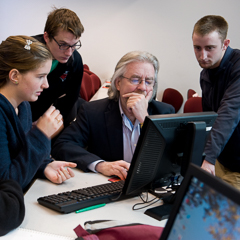About Hybrid Instruction
A Flexible Hybrid Learning Environment

The most noticeable changes next year will come in the arena of instructional delivery. Nearly every course at Fordham will adopt a flexible hybrid learning environment. This means that course elements that primarily involve the presentation of ideas or independent learning will be designed ahead of time and delivered asynchronously, for students to access on demand. Interactive components, such as discussions and small group meetings, will take place synchronously, in real time, and will be taught in intensive, personalized ways.
Some departments have already begun to lay plans for developing the asynchronous portions of multi-section courses collaboratively, so that students enrolled in all sections of these courses will benefit from high-quality, team-taught content. Because creating videos and presentations, designing digital interactive experiences, and moderating online discussions are unfamiliar practices for many instructors, Fordham will provide substantially expanded pedagogical and technical support to all who teach.
We Listened to You
Numerous faculty members, administrators, staff members, and especially students contributed their insights and feedback as part of our planning for the continuity and resilience of the University’s academic enterprise including:
- More than 170 faculty and staff
- More than sixty students (admitted undergraduates and current undergraduate, graduate, and professional students)
- Several dozen administrators with expertise in technical areas
- A group of twenty-one members of our Academic Review Team
Learn more about the academic planning process.
Why Hybrid Instruction?

We believe that, intrinsically, there are benefits to methods of teaching and learning that prioritize interaction and enable students to work through lectures and other forms of knowledge acquisition on their own time. The complications of COVID-19, however, offer two additional compelling reasons:
Limited Classroom Capacity
When we return to campus, public health regulations will almost certainly require us to reduce seating capacity in all of our classrooms. The flexible hybrid learning environment will enable an instructor, for instance, to divide the scheduled class time per week into two or more time slots and meet with smaller groups of students in the various time slots.
Complementary asynchronous instructional modules will fill out the rest of the course and help prepare students to take part in the more intensive and personalized interactive sessions. Because this approach does not fit every section in the same way, we will publish revised classroom seating capacities once they are determined and ask each instructor to decide how best to satisfy this public health requirement.
Flexibility to Pivot to Remote Instruction
Anticipating that at various points during the academic year, individual students or instructors may not be able to be physically present in class (for reasons of illness, self-isolation, a compromised immune system, delays in gaining a student visa, etc.), such individuals will still be able to engage in synchronous components of their courses through videoconferencing technology (e.g., Zoom or Blackboard Collaborate).
If a resurgence of the virus necessitates that Fordham suspends all face-to-face instruction for a period, the asynchronous portions of courses would be unaffected, while the synchronous portions would continue via videoconferencing technology with minimal disruption.
Synchronous Versus Asynchronous
Synchronous learning is online or distance education that happens in real-time, whereas asynchronous learning occurs through online channels without real-time interaction.